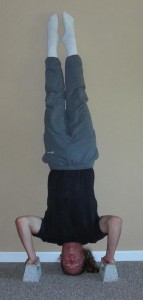The handstand clap pushup is an amazing skill. In this post you’ll learn about and see a couple different ways to do it.
Although it’s called a “pushup” the truth is the easiest way to do it is to not really do a pushup. By generating a jumping action from the feet you can launch yourself into the air, clap, and then land back in the handstand.
Here is a good example of that. There is only a slight bend in the arms before launching and when landing.
Contrast that to this one. Here the jump is generated fully from the legs, but it is not caught in a handstand position or even close to it. The guy ends up in basically the bottom of the handstand pushup and must press back up.
Now here is where it truly becomes handstand pushup with claps and not just a jumping handstand with a clap. Not only does he not use the legs at all but he manages several reps in a row.
These strict handstand clap pushups are tough to do. Even the earlier version are going to be outside the realm of what most people can manage.
To work up to this skill I would recommend:
1) Learn how to hold a stable handstand.
2) Build handstand pushup strength.
3) Learn how to jump with your hands (if you’re going for that version).
4) Build a lot more handstand pushup strength (for the strict version).
















